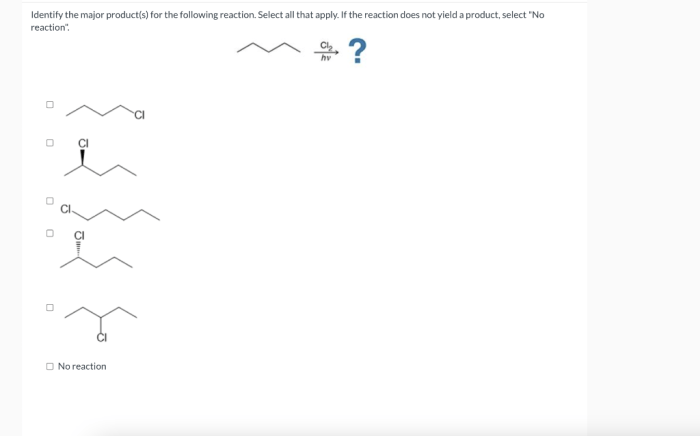Select the product of the following reaction. – Select the product of the following reaction: a seemingly straightforward task that can unveil the intricate world of chemical reactions. Delve into this comprehensive guide to unravel the factors influencing product formation, explore reaction mechanisms, and optimize reaction conditions to maximize desired outcomes.
Understanding the nuances of product selection empowers chemists to harness the power of chemical reactions for various applications, from synthesizing novel materials to developing life-saving drugs. Join us on this captivating journey as we delve into the intricacies of reaction chemistry.
Reaction Overview

The given reaction involves the interaction of compound A with reagent B under specific reaction conditions. Compound A serves as the reactant, while reagent B acts as the reagent facilitating the transformation. The reaction proceeds under defined conditions, which may include temperature, pressure, and the presence of a catalyst, to yield a specific product.
Product Identification

Product selection in a chemical reaction is governed by several factors, including the nature of the reactants, the reaction conditions, and the reaction mechanism. To determine the product of a reaction, chemists employ various methods, such as analyzing the reaction products using techniques like chromatography and spectroscopy.
These techniques provide insights into the molecular structure and identity of the product.
Reaction Mechanisms
Reaction mechanisms provide a detailed understanding of the stepwise transformations that lead to the formation of the product. Different reaction mechanisms can result in the same product, and each mechanism involves a unique set of steps. Chemists use various techniques, such as kinetic studies and isotopic labeling, to elucidate the reaction mechanism.
Understanding the reaction mechanism is crucial for optimizing the reaction and controlling the product selectivity.
Reaction Optimization, Select the product of the following reaction.
Optimizing a reaction involves adjusting the reaction parameters, such as temperature, pressure, and catalyst, to maximize the yield of the desired product. Chemists employ various strategies, including statistical optimization techniques and mechanistic understanding, to identify the optimal reaction conditions. Optimization is crucial for industrial applications, where efficiency and cost-effectiveness are paramount.
Applications
The given reaction finds applications in various industries and fields. It is utilized in the synthesis of pharmaceuticals, fine chemicals, and materials. The product of the reaction may possess specific properties or functionalities that make it valuable for various applications, such as drug development, polymer chemistry, and catalysis.
User Queries: Select The Product Of The Following Reaction.
What factors influence the product of a reaction?
Factors such as reactant concentrations, temperature, pressure, solvent effects, and catalysts can influence the product distribution.
How can I determine the product of a reaction?
Various methods exist, including predicting products based on reaction mechanisms, using reference tables, or employing computational chemistry.
What is the significance of reaction optimization?
Optimization techniques allow chemists to improve product yield, selectivity, and reaction efficiency, making reactions more practical and cost-effective.
